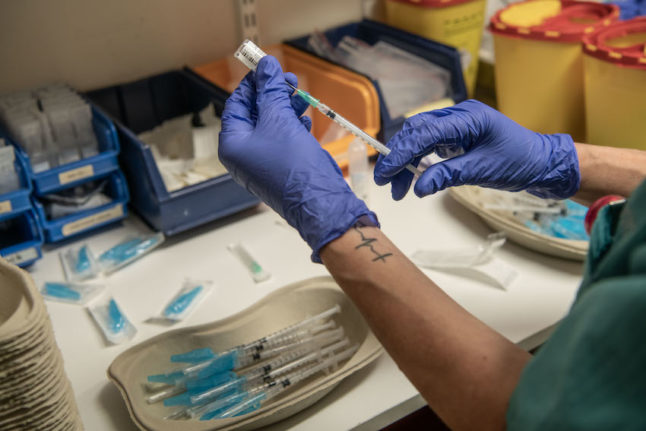Firstly, what do the numbers actually tell us?
The number of new Covid-19 cases reported in Sweden has been increasing during September, after it fell sharply during the summer.
In Stockholm the change is even more clearly pronounced, where the 7-day rolling average reached 81 new cases on September 21st after a low of 29 at the start of the month.
“It is a worrying trend – although most positive cases have been detected in the younger part of the population, and thereby no apparent increases in the number of severe cases or deaths. However, protecting risk groups will be a more difficult task if the increase continues,” Jonas Björk, a professor in epidemiology at Lund University, told The Local.
Increased testing probably plays a part, meaning more mild cases have been detected, but that can't explain the increase entirely.
Sweden has carried out many more tests in September than it ever has before: 139,471 in the week ending September 20th; 142,673 in the week before that, and 126,188 the week before that. That's around twice as many tests per week than in August (when an average of 65,239 tests were carried out each week).
But as well as simply reporting more cases in absolute numbers, the proportion of tests coming back positive is also showing signs of rising after falling throughout August. The proportion of positives in Sweden last week was 1.5 percent, according to the Public Health Agency, up from 1.2 percent the two weeks before. This suggests the virus is spreading at a higher level than during August.
This rise isn't unexpected to the scientific community, and factors such as changes to socialising habits and the weather are probably part of the reason for increased infection.
“I would have expected an increase,” epidemiologist Emma Frans told The Local. “During the summer people aren't socialising as much, they are not commuting to work or meeting their co-workers. Now data from mobile network Telia shows that people are going to work more than during spring, and higher education is also back to being face-to-face after being web-based in spring.”
And the cooler weather in autumn and winter could give the virus even further momentum, since other coronaviruses spread more effectively in cold, dry weather.
So should we be worried?
The big question is whether the rise in cases will continue, as it has in other parts of Europe, and whether it will translate to a rise in serious illness and deaths.
Jonas Björk warned: “We should not relax or think that the increases that have been observed in several other countries in Europe cannot happen in Sweden too. We still have large parts of the population that have not had the disease – and we also had substantial regional variation in how bad the first wave hit the country. I think we must be prepared that life is going to continue to be different in several ways for quite some time.”
Sweden has not yet seen the sharp rises in new cases reported in other countries; however, new infections remained at a high level for longer in Sweden compared to other countries that went into lockdown. Epidemiologist Emma Frans says it is possible that the country is at a different phase and will soon see the same development as in other parts of Europe.
But she also noted that in Sweden as well as other European countries, wider testing means more mild cases are being picked up.
“There's a delay; people are admitted to intensive care maybe two weeks after they get infected, and if they die that may be three to four weeks later. But that doesn't fully explain the fall in serious cases. In spring there was huge under-reporting, so even if numbers get as high or higher than in spring, there were probably still more people who were infected in spring,” Frans explained.
Whether a high infection rate leads to more deaths also depends on how well a country is able to protect its most vulnerable inhabitants.
The failure to protect Sweden's elderly from the virus has been the biggest flaw in the coronavirus response, but there is some hope that an improved testing system and procedures within the sector will mean it is better placed to deal with a second wave.
“There have been large improvements within elderly care, staff are now tested much more extensively, there are new hygiene routines, so even though we expect an increase [in coronavirus cases] in fall, I think we won't have the same situation as in spring in terms of serious illness,” said Emma Frans.
What should we expect next?
The rise in cases emphasises the need to keep following the regulations currently in place and act with caution.
That includes working from home, limiting social contacts, and staying at home if experiencing any signs of illness. These are restrictions likely to place a higher burden on the individual during Sweden's cold winters, when it is impossible to socialise outside in the same way as in summer, and seasonal colds and flus mean more people experiencing symptoms, which places a burden on testing facilities.
Authorities have said they will introduce further restrictions if needed, with a particular focus on local restrictions where there are signs of an outbreak.
“I don't think any new restrictions will be national as they were in spring. Nationally I think we will have what we have now, and some restrictions may even be lifted, like the ban on visiting nursing homes will be, and restrictions on public events may be changed,” Frans said. “But locally, there might be harsher restrictions than we have seen before: quarantining people who share households with someone with a confirmed diagnosis; there have also been discussions about facemasks.”
In late August, state epidemiologist Anders Tegnell told The Local that restrictions on indoor socialising at home were not on the cards, and Frans thinks this is likely to remain the case.
“I think the overall idea is that it should be easy to follow the recommendations. In many countries it becomes a conflict of interest between a government wanting to stop the virus at any price and people who want to go on with their daily lives, socialise and take children to school. That's why we haven't gone down that route and I don't think we will in fall either,” she said.



 Please whitelist us to continue reading.
Please whitelist us to continue reading.
Member comments